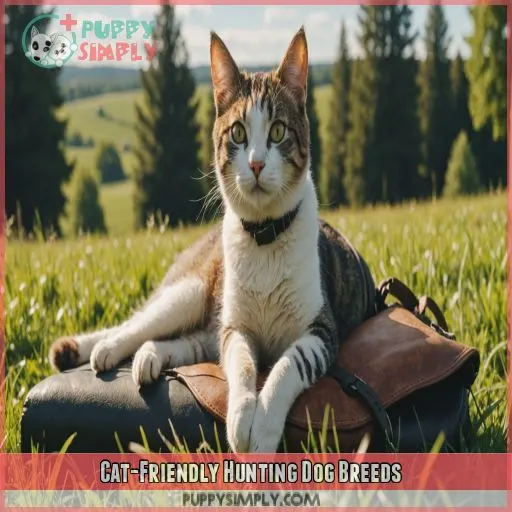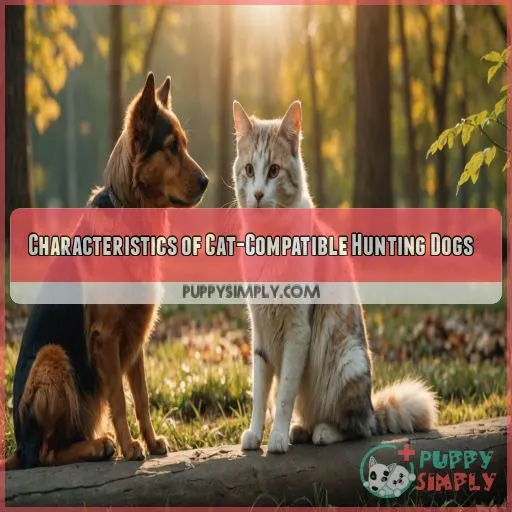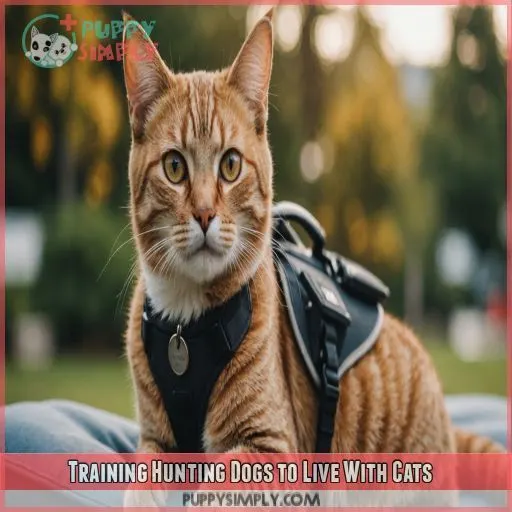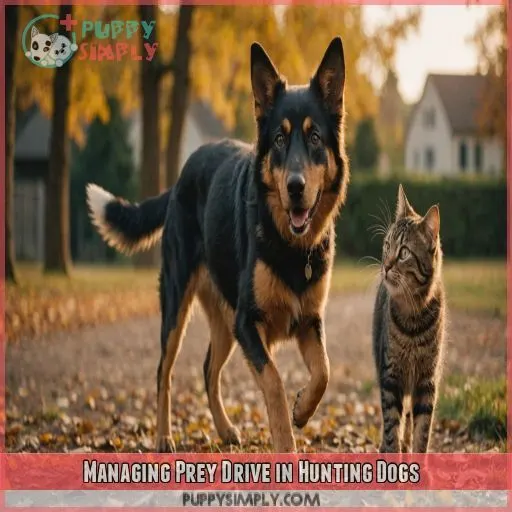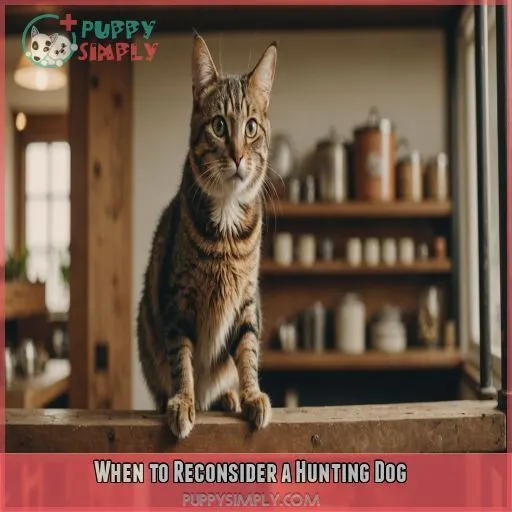This site is supported by our readers. We may earn a commission, at no cost to you, if you purchase through links.
 You might think hunting dogs and cats are sworn enemies, but some breeds can surprise you!
You might think hunting dogs and cats are sworn enemies, but some breeds can surprise you!
The best hunting dog breeds for cats are often gentle giants with low prey drives.
Labrador Retrievers, Golden Retrievers, and Beagles top the list, thanks to their friendly nature and trainability.
These pups can learn to see kitties as pack members rather than prey.
Basset Hounds and Greyhounds are unexpected cat-friendly choices, with their laid-back attitudes and couch potato tendencies.
With the right approach, you might just find your hunting dog and cat cuddling up together for naptime.
But what about those hunting instincts?
Table Of Contents
- Key Takeaways
- Top Dog Breeds Compatible With Cats
- Golden Retrievers: Gentle Giants for Feline Friends
- Labrador Retrievers: Friendly and Adaptable Companions
- Cavalier King Charles Spaniels: Affectionate and Cat-Friendly
- Beagles: Pack-Oriented Dogs That Welcome Cats
- Pugs: Playful Pals for Feline Housemates
- Bichon Frises: Entertaining Companions for Cat Households
- Collies: Nurturing Nature Extends to Cats
- Shetland Sheepdogs: Mild-Mannered and Cat-Welcoming
- Basset Hounds: Laid-back Loungers Alongside Cats
- Poodles: Intelligent Breed Suitable for Multi-Pet Homes
- Cat-Friendly Hunting Dog Breeds
- Characteristics of Cat-Compatible Hunting Dogs
- Hound Breeds That Can Coexist With Cats
- Training Hunting Dogs to Live With Cats
- Managing Prey Drive in Hunting Dogs
- Creating a Harmonious Multi-Pet Household
- Breed-Specific Considerations for Cat-Dog Households
- When to Reconsider a Hunting Dog
- Frequently Asked Questions (FAQs)
- How old should a hunting dog be when introduced to cats?
- Can hunting dogs and outdoor cats peacefully coexist?
- Are mixed-breed hunting dogs less likely to chase cats?
- How does spaying/neutering affect a hunting dogs cat compatibility?
- What role does early socialization play in cat-friendly hunting dogs?
- Conclusion
Key Takeaways
- You’ll want to look for hunting dog breeds with low prey drives, as they’re less likely to chase your feline friends—think gentle giants like Labrador Retrievers, Golden Retrievers, and Beagles.
- When introducing a hunting dog to your cat, it’s essential to do it slowly and under controlled circumstances to avoid any, ahem, cat-astrophes—start with visual introductions, then progress to scent mixing and supervised meetups.
- You can teach your hunting dog to live harmoniously with your cat by focusing on obedience training, positive reinforcement, and redirecting their energy away from chasing instincts—yes, it’s possible to have a cat-friendly hunting dog!
- Remember, every dog is different, so it’s crucial to consider factors like breed-specific traits, energy levels, and grooming needs when choosing a hunting dog to join your feline-friendly household—with patience and the right approach, you can create a harmonious home where everyone gets along.
Top Dog Breeds Compatible With Cats
You might be surprised to learn that some hunting dog breeds can actually make great companions for cats. Let’s explore the top dog breeds that are known for their compatibility with felines, including some unexpected choices that’ll make you do a double-take.
Golden Retrievers: Gentle Giants for Feline Friends
Golden Retrievers: furry peacekeepers in your pet kingdom. These gentle giants are ideal companions for cats:
- Renowned for their kindness
- Empathetic nature
- Easily trainable
- Adaptable to multi-pet homes
Labrador Retrievers: Friendly and Adaptable Companions
Labrador Retrievers: gentle giants welcoming cats into their pack. Here’s why they’re paw-some feline friends:
| Trait | Benefit | Cat-Friendly Factor |
|---|---|---|
| Friendly | Accepts new family members | High |
| Adaptable | Adjusts to multi-pet homes | Excellent |
| Patient | Tolerates cat antics | Very Good |
| Playful | Engages cats in fun activities | Good |
Cavalier King Charles Spaniels: Affectionate and Cat-Friendly
The charming Cavalier King Charles Spaniel, with its gentle nature, often becomes a cat’s unexpected best friend.
Beagles: Pack-Oriented Dogs That Welcome Cats
While Cavaliers charm with grace, Beagles bring a different vibe to cat-friendly homes. These pack-oriented pups welcome feline friends with:
- Sociable nature
- Adaptable personalities
- Playful energy
- Strong pack mentality
Pugs: Playful Pals for Feline Housemates
Their playful nature and low-key energy often lead to adorable Pug-cat bonds.
Bichon Frises: Entertaining Companions for Cat Households
You’ll love Bichon Frises! These fluffy jokesters will keep both you and your cat entertained for hours.
Collies: Nurturing Nature Extends to Cats
With their nurturing nature, Collies often extend their love to cats, making them excellent multi-pet companions.
Shetland Sheepdogs: Mild-Mannered and Cat-Welcoming
Shetland Sheepdogs, or Shelties, are a hidden gem for cat lovers. These pint-sized pooches offer:
- Mild manners
- High trainability
- Welcoming attitude
Basset Hounds: Laid-back Loungers Alongside Cats
You’ll love Basset Hounds! These laid-back loungers are more interested in napping than chasing your feline friends.
Poodles: Intelligent Breed Suitable for Multi-Pet Homes
With their smarts and adaptability, Poodles excel in multi-pet homes. They’re:
- Highly trainable
- Low-shedding
- Great with cats
Cat-Friendly Hunting Dog Breeds
While many hunting breeds have strong prey drives, you’ll be pleasantly surprised to learn that some can be fantastic feline friends! Let’s explore a few unexpected canine companions that’ll have your cats purring with delight. Check out this table of cat-friendly hunting dogs that’ll make you do a double-take:
| Breed | Hunting Style | Cat-Friendliness |
|---|---|---|
| Beagle | Scent hound | High |
| Labrador | Retriever | Very high |
| Pointer | Bird dog | Moderate |
| Spaniel | Flushing dog | High |
| Basset Hound | Scent hound | Very high |
These breeds prove that even working dogs can be purr-fect companions for your feline friends!
Characteristics of Cat-Compatible Hunting Dogs
You might think hunting dogs and cats are sworn enemies, but some breeds can actually make great feline companions. Let’s explore the key traits that make certain hunting dogs surprisingly compatible with their feline friends, from their low prey drive to their gentle nature.
Low Prey Drive: Essential for Cat Safety
In terms of cat safety, a dog’s prey drive is the elephant in the room. You’ll want a hunting breed with a low chase instinct. Look for dogs that:
- Ignore small, fast-moving objects
- Remain calm around cats
- Show little interest in pursuing wildlife
- Prefer cuddles to chasing
Trainability: Importance of Obedience Around Cats
Beyond low prey drive, a dog’s trainability is key. You’ll want a pooch that’s quick to learn obedience commands. This skill helps manage interactions with your feline friend, keeping everyone safe and happy.
Gentle Temperament: Key to Peaceful Coexistence
A gentle temperament is the secret sauce for peaceful dog-cat coexistence. Your hunting dog should be:
- Calm around feline friends
- Patient with cat antics
- Soft-mouthed during play
- Responsive to "leave it" commands
Social Nature: Accepting Cats as Pack Members
You’re in luck! Some hunting dogs have a knack for treating cats like pack members. Let’s explore how these social pups can turn your home into a harmonious multi-species haven.
| Breed | Social Traits | Cat-Friendly Rating |
|---|---|---|
| Beagle | Pack-oriented | |
| Labrador | People-pleaser | |
| Golden Retriever | Gentle giant | |
Energy Levels: Matching Activity With Feline Housemates
When picking a hunting dog, consider your cat’s energy level. A high-octane pup might overwhelm a lazy kitty, while a couch potato pooch could bore an active feline. Aim for a harmonious balance!
Size Considerations: Impact on Cat Comfort
While energy matters, size can make or break your cat’s comfort. When choosing a hunting dog, consider:
- Space constraints
- Safe zones for your cat
- Cat furniture placement
- Play space requirements
Bigger isn’t always better!
Hound Breeds That Can Coexist With Cats
You might be surprised to learn that some hound breeds, traditionally known for their hunting instincts, can actually make great companions for cats. Let’s explore a few unexpected hound breeds that have shown a knack for peaceful coexistence with their feline friends, defying their reputation as chase-happy pups.
Beagles: Social Nature Trumps Hunting Instincts
You’d think Beagles’ hunting instincts would make them cat-chasers, but surprise! These pups are social butterflies who view cats as potential pals. Their pack mentality means they’re more likely to curl up with your kitty than chase it. Talk about a plot twist in the canine world!
Basset Hounds: Calm Demeanor Suits Cat Households
While Beagles charm with sociability, Basset Hounds steal the show with their laid-back nature. These droopy-eared hounds are a cat owner’s dream, thanks to their calm demeanor. You’ll find them more interested in napping than chasing your feline friend, making for a harmonious household.
Greyhounds: Surprising Compatibility With Felines
While Basset Hounds are known couch potatoes, Greyhounds might surprise you as cat-friendly companions. These gentle giants are often couch potatoes themselves, with a calm demeanor that suits feline friends. Their low prey drive and affectionate nature make them unexpectedly compatible housemates for your kitty.
Whippets: Gentle Giants Among Cats
Despite their racing heritage, Whippets are surprisingly gentle giants around cats. You’ll find these sleek hounds often cuddling up with feline friends. Their calm demeanor and low prey drive make them excellent companions in multi-pet households. Just remember, proper introductions and supervision are key to harmony.
Training Hunting Dogs to Live With Cats
Believe it or not, you can train hunting dogs to peacefully coexist with cats. With the right approach and consistent effort, you’ll be surprised at how well these natural-born hunters can learn to view your feline friends as part of the family pack.
Early Socialization: Introducing Dogs to Cats
While some hounds can befriend cats, early socialization is key for hunting dogs. Start by:
- Creating a scent-familiar environment
- Using baby gates for visual introduction
- Leashing your dog during initial meetings
- Offering treats for calm behavior
This gradual approach sets the stage for harmony.
Positive Reinforcement: Rewarding Calm Behavior Around Cats
When your hunting dog stays calm around your cat, it’s time to break out the treats! Positive reinforcement works wonders in teaching these unlikely housemates to coexist peacefully. Here’s a quick guide to rewarding good behavior:
| Reward Type | Timing | Effect |
|---|---|---|
| Treats | Immediate | Strongest association |
| Praise | Ongoing | Builds confidence |
| Play | After calm interaction | Reinforces positive experience |
Establishing Boundaries: Creating Safe Spaces for Cats
Your cat’s kingdom needs safe havens from curious canines. Create feline-friendly spaces by:
- Installing vertical escapes
- Designating quiet zones
- Establishing scent boundaries
- Separating food areas
These boundaries will help your furry friends coexist peacefully, like a well-orchestrated symphony of paws and whiskers.
Leash Training: Controlling Dog-Cat Interactions
With safe spaces set, it’s time to hit the streets! Leash training‘s your secret weapon for harmonious cat-dog encounters. Use gentle leads and positive reinforcement to teach your pup proper manners around felines. It’s a walk in the park!
Supervised Playtime: Fostering Positive Relationships
Now that your pup’s leash manners are excellent, it’s time for some furry fun! Supervised playtime is your ticket to a harmonious household. Keep a watchful eye as Fido and Fluffy frolic, rewarding good behavior and stepping in if things get too rowdy.
Managing Prey Drive in Hunting Dogs
You might think hunting dogs and cats are sworn enemies, but with the right approach, they can become unlikely friends. Let’s explore how to manage your hunting dog’s prey drive, ensuring your feline friend stays safe and stress-free in your multi-pet household.
Recognizing Triggers: Identifying Cat-Chasing Stimuli
Spot those "Aha!" moments when your hunting dog’s ears perk up at Fluffy. Movement triggers, prey mimicry, sound stimuli, scent cues, and visual signals can all set off the chase instinct. Recognizing these triggers is your first step to harmony.
Redirect Techniques: Channeling Energy Away From Cats
When your pup’s got its eye on the cat, it’s time to pull out the big guns! Redirect that energy with toy distractions, scent trails, or agility training. Food puzzles can keep their mind off mischief and onto tasty treats instead.
Exercise Regimen: Tiring Dogs to Reduce Prey Drive
While redirection helps, an exhausted dog is less likely to chase cats. Try agility training, fetch variations, or swimming exercises. Even long walks or treadmill workouts can do wonders. Remember, a tired pup is a good pup!
Mental Stimulation: Engaging the Dog’s Mind
Beyond physical exercise, mental workouts can curb your hunting dog’s prey drive. Keep their sharp minds busy with:
- Puzzle toys that dispense treats
- Scent work games in the yard
- Learning new tricks and commands
This brain drain helps Fido focus on you, not Felix!
Professional Training: Seeking Expert Help for Persistent Issues
When your pup’s prey drive persists, it’s time to call in the pros. A skilled trainer can work wonders, tailoring techniques to your dog’s needs. They’ll guide you through the process, ensuring lasting results and a happy cat-dog household.
Creating a Harmonious Multi-Pet Household
You’ve got your hunting dog and your feline friend, but how do you make sure they live in harmony? Creating a peaceful multi-pet household isn’t rocket science, but it does require some clever strategies and a dash of patience to keep both your furry companions happy and stress-free.
Multiple Litter Boxes: Ensuring Cat Comfort and Privacy
While managing prey drive is key, don’t forget about your cat’s needs. Multiple litter boxes are a must in multi-pet homes. You’ll want to strategically place them, keep ’em clean, and choose the right size. It’s like giving your kitty a private bathroom – no doggy interruptions!
Vertical Spaces: Providing Cat Escape Routes
For maintaining harmony, think vertical! Install cat trees, wall shelves, and high perches to give your feline friend a quick escape route. These elevated spaces provide safety and satisfy your cat’s natural climbing instincts. It’s a win-win for everyone!
Scent Mixing: Familiarizing Pets With Each Other’s Odors
Your pets’ noses know best! Swap scents between your furry friends using shared bedding or grooming tools. It’s like giving them a sneak peek of their new roommate. Try pheromone products or scented toys to create a comforting, familiar environment for both species.
Gradual Introductions: Slowly Acclimating Pets to Cohabitation
Want to avoid a cat-astrophe? Start slow! Gradually introduce your hunting dog to your feline friend using visual barriers and neutral territories. Swap scents, establish feeding rituals, and share toys to build positive associations. Remember, Rome wasn’t built in a day—and neither are paw-some pet friendships!
Breed-Specific Considerations for Cat-Dog Households
When choosing a hunting dog to live with your cat, you’ll need to think about more than just their prey drive. From size differences to energy levels, grooming needs to vocalization habits, each breed brings its own set of characteristics that can make or break a harmonious household with your feline friend.
Size Differences: Managing Large Dogs With Small Cats
With your pets’ living spaces sorted, let’s talk size. When you’ve got a big pup and a tiny kitty, it’s all about smart management. Create safe zones, supervise playtime, and set clear boundaries. Your gentle giant can be a purr-fect pal!
Energy Levels: Matching Dog Activity to Cat Tolerance
While size matters, energy’s the real game-changer. You’ll want to match your pup’s zip with your cat’s chill factor. A high-energy hunting dog might send your feline friend running for the hills faster than you can say "fetch!
Grooming Needs: Impact on Household Dynamics
Grooming is something to think about when it comes to time commitment. Some hunting breeds shed like crazy, while others need frequent brushing. Your cat mightn’t appreciate a furry tornado in the living room!
Vocalization: Considering Barking and Cat Stress
You’ll want to think about your dog’s vocal tendencies. Some breeds are real chatterboxes, which can stress out your feline friend. Keep an ear out for barking triggers and cat stress cues. A little soundproofing might just save your sanity!
Space Requirements: Accommodating Multiple Pets Comfortably
In a multi-pet home, space is important. To keep the peace, consider:
- Multi-pet furniture for shared lounging
- Cat-friendly zones with vertical spaces
- Designated areas for each pet’s belongings
- Safe havens for your feline friends
When to Reconsider a Hunting Dog
While hunting dogs can make wonderful companions, there are times when you might need to reconsider bringing one into your cat-friendly home. Let’s explore the signs that indicate a hunting dog mightn’t be the best fit for your feline-filled household, and what you can do to make sure harmony between your furry friends.
Persistent Aggression: Recognizing Incompatible Behavior
While size and energy levels matter, sometimes dogs just can’t shake their hunting instincts. If your pup consistently shows aggression toward your cat, it’s time to face the music. Watch for growling, lunging, or intense staring these are red flags you can’t ignore.
Stress Signs in Cats: Identifying Feline Discomfort
Keep your eyes peeled for these telltale signs of cat stress when introducing a hunting dog:
- Excessive grooming or hiding
- Changes in appetite or litter box habits
- Aggressive behavior or vocalization
- Dilated pupils or flattened ears
Don’t brush off these red flags—they’re your cat’s way of saying, "Houston, we’ve a problem!
Breed-Specific Challenges: Acknowledging Insurmountable Instincts
While some hunting dogs can be cat-friendly, certain breeds just can’t shake their instincts. You might be barking up the wrong tree if your pup’s prey drive is off the charts. Consider the breed’s history, your experience, and training limitations before bringing a hunter home.
Home Environment: Assessing Suitability for Multiple Pets
While breed instincts matter, your home’s layout is equally important. Do you have enough space for both cats and dogs? Can you create separate feeding areas and safe zones? Consider your budget for multiple pets and how they’ll fit into your daily routine.
Frequently Asked Questions (FAQs)
How old should a hunting dog be when introduced to cats?
You’ll want to introduce your hunting pup to cats as early as possible, ideally between 8-16 weeks old. This prime socialization window helps your furry friend learn to coexist peacefully with feline family members. It’s a tail-wagging success!
Can hunting dogs and outdoor cats peacefully coexist?
Like a modern-day Tom and Jerry, hunting dogs and outdoor cats can coexist peacefully. You’ll need patience, training, and supervision. Introduce them gradually, provide safe spaces for your cat, and teach your dog the "leave it" command.
Are mixed-breed hunting dogs less likely to chase cats?
Mixed-breed hunting dogs aren’t necessarily less likely to chase cats. It’s more about individual temperament and training. You’ll need to work on obedience and proper introductions, regardless of breed. Remember, even Fido’s feline friend can become a furry target!
How does spaying/neutering affect a hunting dogs cat compatibility?
Spaying/neutering can mellow your hunting dog’s instincts, potentially making them more cat-friendly. It’s not a guarantee, but it might take the edge off their prey drive. Remember, training and early socialization are still key to harmony!
What role does early socialization play in cat-friendly hunting dogs?
Early socialization is really important for your hunting pup’s cat-friendliness. It’s like teaching a kid manners – start young! Expose your furry friend to cats early on, and you’ll shape a well-rounded, feline-friendly companion. It’s a game-changer!
Conclusion
Choosing the best hunting dog breeds for cats may seem like finding a needle in a haystack, but it’s easier than you think!
With patience, training, and the right breed, you can create a harmonious household where fur flies in playful delight rather than fearful flight.


